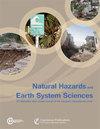利用全球适用框架模拟复合洪水风险和降低风险:莫桑比克索法拉省的试点项目
IF 4.7
2区 地球科学
Q1 GEOSCIENCES, MULTIDISCIPLINARY
引用次数: 2
摘要
摘要在低洼的沿海地区,洪水由河流、洪积物和沿海驱动因素(组合)引起。如果这些洪水具有统计相关性,如果不考虑相关性,它们的联合概率可能会被表示出来。然而,很少有研究在考虑所谓的复合洪水时检查洪水风险和风险降低措施。我们提出了一个全球适用的框架,用于使用流体动力学、影响和统计建模进行综合洪水风险评估,并将其应用于莫桑比克索法拉省的一个案例研究。该框架大致由三个步骤组成。首先,从再分析数据中导出了一个大的随机事件集,考虑了所有年最大洪水驱动因素的共同发生和相互依赖性。然后,模拟了非洪水和洪水条件下不同驱动因素组合的洪水危害和影响。最后,从模拟事件中对每个随机事件的影响进行插值,以得出完整的洪水风险剖面。我们的案例研究结果表明,从所有驱动因素来看,尽管存在广泛的河流和洪泛洪水危险,但沿海洪水在该地区造成的风险最大。当考虑到与独立性相比观察到的统计依赖性时,重现期超过25年的事件更具破坏性,例如12 % 100年一遇。然而,就预计的年损失而言,总的复合洪水风险仅为0.55 % 更大。这可以解释为,对于对风险贡献最大的频繁事件,模拟了洪水驱动因素之间有限的物理相互作用。我们还评估了三项措施在降低风险方面的有效性。就我们的情况而言,基于2年一遇洪泛平原的分区与10年一遇保护级别的分区一样有效,而防干等级高达1 m不能达到同样的效果。由于该框架基于全球数据集,并且在很大程度上是自动化的,因此可以很容易地在其他地区重复使用,以进行复合洪水风险的一阶评估。虽然评估的质量将取决于全球模型和数据的准确性,但它可以很容易地包括更高质量的(本地)数据集,以进一步改进评估。本文章由计算机程序翻译,如有差异,请以英文原文为准。
Modeling compound flood risk and risk reduction using a globally applicable framework: a pilot in the Sofala province of Mozambique
Abstract. In low-lying coastal areas floods occur from
(combinations of) fluvial, pluvial, and coastal drivers. If these flood
drivers are statistically dependent, their joint probability might be
misrepresented if dependence is not accounted for. However, few studies have examined flood risk and risk reduction measures while accounting for
so-called compound flooding. We present a globally applicable framework for
compound flood risk assessments using combined hydrodynamic, impact, and
statistical modeling and apply it to a case study in the Sofala province of
Mozambique. The framework broadly consists of three steps. First, a large
stochastic event set is derived from reanalysis data, taking into account
co-occurrence of and dependence between all annual maximum flood drivers.
Then, both flood hazard and impact are simulated for different combinations
of drivers at non-flood and flood conditions. Finally, the impact of each
stochastic event is interpolated from the simulated events to derive a
complete flood risk profile. Our case study results show that from all
drivers, coastal flooding causes the largest risk in the region despite a
more widespread fluvial and pluvial flood hazard. Events with return periods longer than 25 years are more damaging when considering the observed
statistical dependence compared to independence, e.g., 12 % for the
100-year return period. However, the total compound flood risk in terms of
expected annual damage is only 0.55 % larger. This is explained by the
fact that for frequent events, which contribute most to the risk, limited
physical interaction between flood drivers is simulated. We also assess the
effectiveness of three measures in terms of risk reduction. For our case,
zoning based on the 2-year return period flood plain is as effective as
levees with a 10-year return period protection level, while dry proofing up
to 1 m does not reach the same effectiveness. As the framework is based on
global datasets and is largely automated, it can easily be repeated for
other regions for first-order assessments of compound flood risk. While the
quality of the assessment will depend on the accuracy of the global models
and data, it can readily include higher-quality (local) datasets where
available to further improve the assessment.
求助全文
通过发布文献求助,成功后即可免费获取论文全文。
去求助
来源期刊
CiteScore
7.60
自引率
6.50%
发文量
192
审稿时长
3.8 months
期刊介绍:
Natural Hazards and Earth System Sciences (NHESS) is an interdisciplinary and international journal dedicated to the public discussion and open-access publication of high-quality studies and original research on natural hazards and their consequences. Embracing a holistic Earth system science approach, NHESS serves a wide and diverse community of research scientists, practitioners, and decision makers concerned with detection of natural hazards, monitoring and modelling, vulnerability and risk assessment, and the design and implementation of mitigation and adaptation strategies, including economical, societal, and educational aspects.

 求助内容:
求助内容: 应助结果提醒方式:
应助结果提醒方式:


